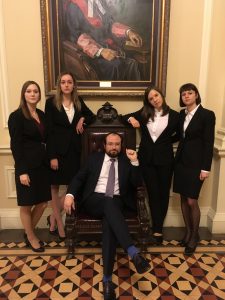While investigating in the aftermath of an armed robbery, a police officer looks at a suspect’s cell phone and sees a text message that reads: “We did it. Where the jewellery at?”.
Should the officer have looked at the cell phone? Does it matter that under section 8 of the Canadian Charter of Rights and Freedoms, everyone has the right to be free from an unreasonable search? How do we balance those rights with the need for effective law enforcement, especially when trying to locate weapons, stolen property and other suspects? Did the Supreme Court of Canada get it wrong?
These were the questions my teammates and I tried to answer in presenting our argument in front of the judges at the Gale Cup Moot.
What’s a moot, anyway?
Towards the end of your first and second years at Allard, you will have the opportunity to try out for a competitive moot. A moot is a mock trial or appeal where teams of students compete against each other in preparing an argument and arguing a case. Allard sends teams across Canada and around the world to compete in moots in criminal law, international law, tax law, Aboriginal law, and many other subject areas. Allard students get course credit for competitive moots.
My moot experience at Allard
Last year, I had the opportunity to be a member of Allard’s team for the Gale Cup Moot. The Gale Cup is a criminal law moot, with the problem often involving the Canadian Charter of Rights and Freedoms. Teams appeal a recent decision from the Supreme Court of Canada – in our case, R. v. Fearon, on the question of whether a police search of a cell phone incident to arrest constituted an unreasonable search.
The preparation began in September, when we received our problem and met with our coach to discuss the case and begin researching. Trying to come up with an argument that is better than the reasons given by the Supreme Court of Canada may sound daunting (and it is), but our team had the guidance of Professor Isabel Grant and coach Ryan Dalziel of Norton Rose Fulbright.
The Gale Cup has two components: written submissions (called a factum) and oral argument. For the oral argument, each team member has 30 minutes to make their argument, during which time the panel of three judges may interrupt and ask questions.
To prepare for the competition, we had practices twice a week with different judges. Our practice judges included commercial litigators, criminal defence lawyers, Crown prosecutors and BC Supreme Court judges. Our final dress rehearsal was held in front of three judges from the BC Court of Appeal. By the time we flew to Toronto for the competition, we knew our case inside and out.
Why think about trying out for a moot?
By participating in a competitive moot, I became a better public speaker and legal writer, I met law students from across the country, and I got to work with a fantastic team. Competing at the Gale has been my favourite law school experience so far and one of the most valuable learning opportunities.
